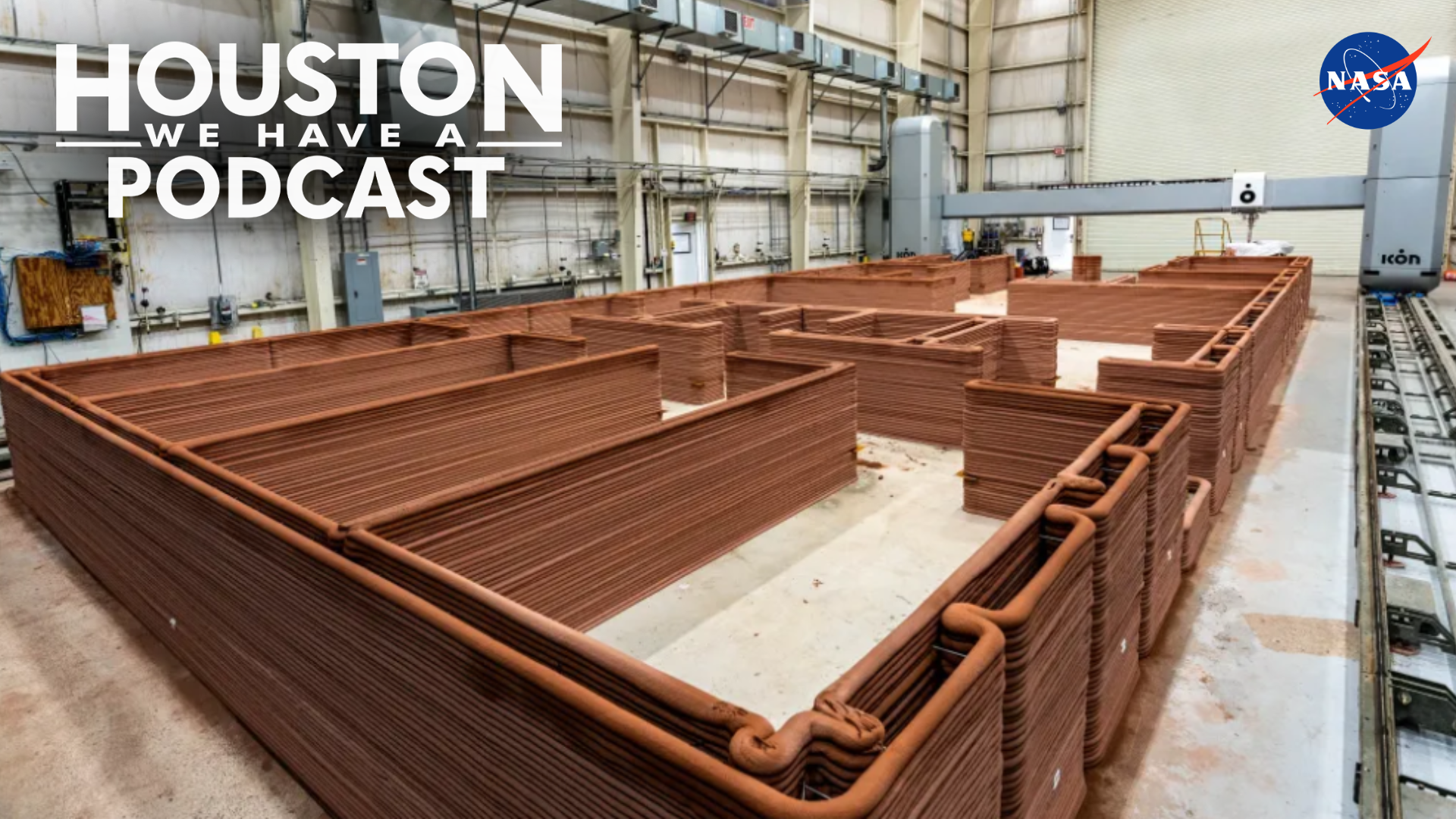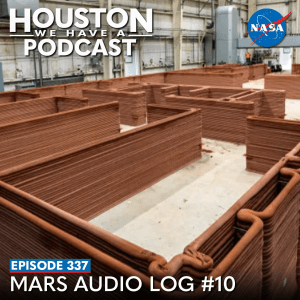
From Earth orbit to the Moon and Mars, explore the world of human spaceflight with NASA each week on the official podcast of the Johnson Space Center in Houston, Texas. Listen to in-depth conversations with the astronauts, scientists and engineers who make it possible.
On episode 337, the CHAPEA crew checks in on their 10th month in a Mars simulated habitat, and a NASA scientist explains her role studying crew habitat design and how it supports health, team cohesion, and performance. This is the 10th audio log of a monthly series. Recordings were sent from the CHAPEA crew throughout April 2024. The conversation with Lauren Blackwell Landon was recorded on May 10, 2024.

Transcript
Host (Gary Jordan): Houston, we have a podcast! Welcome to the official podcast of the NASA Johnson Space Center, Episode 337, “Mars Audio Log #10.” I’m Gary Jordan and I’ll be your host today. On this podcast, we bring in the experts, scientists, engineers, and astronauts, all to let you know what’s going on in the world of human spaceflight and more. We’re back with another audio log from the CHAPEA crew. CHAPEA, or Crew Health and Performance Exploration Analog, is a yearlong analog mission in a habitat right here on Earth that’s simulating very closely what it would be like to live on Mars. We’re lucky enough to have monthly check-ins with the crew: Commander Kelly Haston, Flight Engineer Ross Brockwell, Medical Officer Nathan Jones, and Science Officer Anca Selariu.
To meet the needs of fitting in with this analog and simulating significant communication delays between Earth and Mars that prohibit us from having a live conversation. The crew is recording an audio log based off of the questions that we draft for them. On this episode, we’ll play the recording of their 10th month in the habitat, which is right here at NASA Johnson Space Center and was recorded in April 2024. We’ll also be bringing in a special guest to learn even more about CHAPEA. Last month, we met with the Mars Architecture team who worked with the CHAPEA team, logistics, comm delays, and Mars tasks. This month is on the habitat and group living. Specifically, how the CHAPEA habitat design affects behavioral health and performance. The CHAPEA crew has been confined in this habitat for 10 months. They go outside to do spacewalks, but those are certainly not an everyday occurrence. For the most part, four humans are confined in this space. So how much space do you need? What about private space? Communal space? Human factors weigh significantly into the layout of this design.
Dr. Lauren Blackwell Landon, team risk discipline scientist with KBR based here at the Johnson Space Center, will discuss her role in the habitability component of CHAPEA. She studies crew habitat designs in a way that is more supportive of long-term behavioral health team cohesion and performance. This month, the crew recorded in two pairs of two, with crew members that they have not yet paired with. So let’s start our episode with a check-in from our two pairs of the CHAPEA crew members and then from Lauren Blackwell Landon on the habitability of the Mars Dune Alpha habitat. Let’s get into it.
[Music]
Host: Alright, first, let’s hear from Commander Kelly Haston and Science Officer Anca Selariu.
Kelly Haston: Hello, this is a recording for Houston We Have a Podcast, episode (audio log) 10, and my name is Kelly Haston. I’m the commander of CHAPEA Mission 1.
Anca Selariu: And I’m Anca Selariu, a science officer for CHAPEA Mission 1.
Kelly Haston: So today we’re going to tell you guys a little bit about what’s been going on in our 3D printed habitat during our Mars mission analog. First, we’re going to start off by telling you how everything is going.
Anca Selariu: Well, the good news is we’re still alive.
[Laughs]
Kelly Haston: It’s true. We are absolutely still alive, which is important for making a podcast.
Anca Selariu: And not only that, but we also celebrated T-100 recently. And it’s really weird to start actually counting in in double digits versus three digits all of a sudden. But Kelly here has been doing a fantastic job getting us excited and getting us to celebrate each and every single one of our milestones. And without her enthusiasm, it probably would’ve been different.
Kelly Haston: But that is absolutely untrue. Everyone is quite enthusiastic about our milestones, although maybe I’m a little better at getting us to take an official picture. And we sent out pictures to mission control and on the ground, all the different experts that help us actually accomplish this mission. And it felt really good to know that we were, as Anca says, counting down in double digits. So that was pretty awesome. We’ve done some other stuff though in the last few while.
Anca Selariu: Oh gosh, yes. The accomplishment that we’re very proud of is having finished the Marvel series.
Kelly Haston: Exactly. So to explain, we all brought in different movies. We had a certain amount of data storage that we were allowed to take up. And so the crew collaborated before the mission on bringing in different shows and movies to watch. And when we first started the mission, we made a list of all of the Marvel movies that we had, which was considerable. And we have managed to make our way through all of them and check mark them off. And so we’re very happy that we actually have accomplished this, task in our downtime.
Anca Selariu: But that is not to say that we don’t continue to watch movies. Kelly and I have been making a point to get The Last Kingdom done twice over. And we’re in the middle of the second iteration.
Kelly Haston: It’s true. We have developed a great love of things Viking and Scandinavian while in here. So we have really enjoyed the sort of vividness of the portrayal of the characters and also seeing scenes that are being shot in the countryside where we can see mountains and snow and rain and wind and also flowers. And also seeing people do different things that we don’t get to do in here, like making a sword. So those are some of the things we do as a whole crew, but we also do activities that really actually helped have another crew member with you. And so one that I’m going to bring up is that, and I think that one thing that Anca and I love to do together, and since we’re doing this together, we’ll talk about it, we love to clean the airlock together. So the airlock is the place where we sort of, it’s our last stop before we step out onto the Martian surface. And it gets pretty dusty at times. It also holds like all of our EVA equipment, our Extravehicular Activity equipment. And so we love every once in a while, once a month it’s called for to be given a deep clean and on. And Anca and I love go out there and just really go to town with the cleaning materials. And as you might imagine, by the end of it, they’re all really deep red from like the dust of Mars and it’s really satisfying. And we always have really good chats while we’re out there as well. So it’s kind of like double the pleasure. You get to clean something really deeply, you get to have a real good conversation while you’re doing it. And so that’s something that I love to have help from another crew member with.
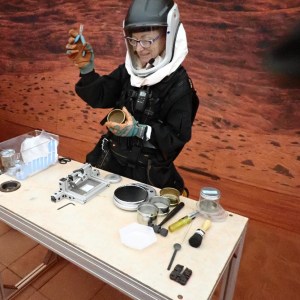
Anca Selariu: That was my first thought when I read this question as well. The cleaning, and it’s very cathartic and it’s very relaxing. And doing this with one of the crew members has been really fun because you also get to have sort of a stream of consciousness and you have interesting conversations about things that you maybe not talk about all the time, but they come to you as you clean. It’s almost like a, yeah, like an exercising activity.
Kelly Haston: It’s true. And it’s also a different use for the room. Normally we’re sort of in and out of that room, right? Like we move through it, we kit up in there and then we move out to the surface, or we are coming back in, we’re carrying things back and forth there. But that’s actually a time where you spend like a considerable amount of time there, not just, you know, in your EVA suit or whatever. So it’s kind of with limited amount of space, it’s nice to use our different rooms for different things and gives you like a little bit of a shake it up of your routine. But Anca, there’s one other thing that I can think about that you actually do a lot with other people, and I think it’s really nice to have a crewmate help you. And that’s the garden.
Anca Selariu: Oh gosh, yes. The garden. It’s so nice when we take care of the plants and either plant or thin them or talk to them or just pet them. Yes, it’s weird, but it’s true.
Kelly Haston: Not all of us cut them. I smell them a lot though. I do smell them a lot.
Anca Selariu: I know I like to pollinate them by hand, so I tend to get in there and just shake them like they’re my pets. They’re fun and it’s fun to actually observe them with the other people. And what I really have enjoyed about having crops is how we collaborate on taking care of them and how we notice, you know, each person seems to notice one new thing about them. And then we work into our activities and crop care all of our inputs and advice from the whole crew. So this is really cool for me.
Kelly Haston: Agreed. I wanted to share one special thought, and it’s something that I think we’ve probably touched on in many ways, but maybe not said explicitly. So, you know, I think when we have done these podcasts in the past, or even when we just talk about the mission in different settings, we all talk about how collaborative it is both in here and with the people on the ground that are the people that designed this experiment and are helping see it through. Right? But I want to say that this is like an even bigger collaborative effort in that like, I want to put a shout out to not only those people in NASA that made this mission, you know, a reality and are continuing to, you know, push us to the finish line as we get closer, but it’s also huge that we’re having so much support from our friends and family. And I don’t think I realized how much really. I mean, I knew they’d be important of course, when we were coming in, when you are going away from people for a year and you’re not going to be able to talk to them in any way, but email and audio files like this, but no direct contact, you knew it. But like, sometimes when I can’t see the big picture, my friends help me see it. So even within my own experience of this mission, I am getting help from people to both remind myself of why it’s important, why we might even be doing something. And that sounds amazing, but it’s really, that comes together for me and creates this mission that is really encompassing every single person that’s supporting us, even if it’s just, you know, my friend’s daughter who sends me an audio asking me to explain some aspect of the mission. And by doing so in language that a kindergarten, you know, kid would understand, I start to actually appreciate aspects of it that, that I don’t always, you know, that I take for granted or don’t even think about. So I just kind of wanted to point out that we talk a lot about our internal things that are going on, and also the people that are supporting us that are in NASA, but it’s much larger than that. And it’s also been like many years in the making, right? We went through an evaluation period. Our families and friends have been dealing with this for a long time along with us. So I just kind of want to say how special, how rich an experience that has been for me and how much I truly, truly appreciate the support from every single angle that I’ve gotten it.

Anca Selariu: You know, you made an excellent point there about how this mission takes a whole world and it’s so important that we keep reminding each other at different time points of that because it’s true. a world inside a 3D printed habitat can be really tiny. And you get to spend a lot of time naval gazing. So you do discover a whole universe within yourself, but then you discover what connects you to everything else. And especially when we get to share these moments and these revelations, we realize how big everything actually is and how important this experience is. I appreciate being reminded that this is a way to keep looking up when the world seems to be looking unpleasant. And it’s critical for me to be supported by the people that you’ve listed, everybody involved in this CHAPEA effort and that includes all the SMEs, all our friends, all family members, and frankly, everybody who ever thinks about Mars and anyone who dreams of space exploration. And just be curious about where we are in the universe is really cool.
Kelly Haston: A hundred percent. Okay so onto some really fun stuff. So we are getting close to the finish relative to the rest of the mission time. And so I’m going to ask Anca, what is the first outdoor activity that you are going to do when you get outside?
Anca Selariu: I think as soon as I see any kind of nature or world that is not a 3D printed habitat, I’m just going to go for a run and keep running until I run out of steam and oxygen. So I have no idea where that’s going to be, but that’s my first thought. Then it would be nice probably to go to the beach, touch sand, although I’m not, you know, in my normal life, I wouldn’t necessarily be crave to go to see a beach. I’ve seen enough sea to last me a couple of lifetimes, and there’s probably got to be a lot more of it in the Navy. But the thing that I really crave is an actual fully equipped gym. I want to return—
Kelly Haston: That’s not outdoors.
[Laughs]
Anca Selariu: Whatever gets me there. How about you?
Kelly Haston: So I definitely am really missing the ocean. I live next to the ocean in Pacifica, the town that I live in near San Francisco. And so I will definitely be driving to Galveston and as soon as I can after we’re out with, with my family members that may be here and getting into the ocean. So I’m really, really craving that. But I miss things from like walking or running the hills and mountains around my town in Pacifica where you have these beautiful vistas of sort of green hills and then also the ocean. But I then am going to visit my father in Kaslo, which is part of the Rockies and British Columbia. And I would like to maybe once again, you know, summit Whitney, Mount Whitney, which is in California, and is a mountain that I’ve climbed several times. So I have so many places that I can’t wait to go. But I think that places that I love right now, the things that are actually familiar to me are the things that call to me. So the ocean, and even just my hometown mountains, which are small and maybe not super robust, but just like, as Anca says, getting out and seeing those things and holding them to your heart while you also are getting your legs and your whole body moving and just experiencing the outdoors while also like pushing yourself to the limit sounds so amazing.
Anca Selariu: Not to mention, and let’s not forget, our Scandinavian trip together that we’ve been plotting and planning already for—
Kelly Haston: Excellent, we will get that in maybe not in 2024. We’re definitely going to get some trips in and I look forward to that in the future. Our crew reunions will undoubtedly be chosen for beautiful places in some way as a tribute to the fact of we gave up a year not being necessarily, being in a different type of beauty and a more limited type. And I hope that when we do crew reunions will honor that by actually going to truly beautiful places and experiencing the outdoors. So that should be really fun. What’s coming up in the next month? So we’re kind of, I’m going to be honest, we’re in kind of the grind of the mission right now. So, you know, as an experiment, we have to repeat a lot of things. And so we’re not doing necessarily a ton of new things right now. We’re doing our exercise, we’re doing our EVAs of different sorts, both virtual reality and non-virtual reality in our sandbox. So we’re doing a lot of repetition right now. It might not sound glamorous, but it is definitely, we still get to do new things that are sort of new flavors of those things when we’re outside. But to be honest, we’re actually really grinding through like a good solid five or six weeks of mostly EVAs, a lot of stuff that we’ve maybe done before, but we’ll be repeating and also our different testing that we’ll be doing. So at the moment we’re kind of a little grindy and I think that that’s, you know, going to be a good challenge for us to actually keep motivated, keep happy while we’re doing, you know, a lot of repetition. That being said, we have several birthdays coming up and we have some other special occasions like Mission Day 300, which is coming up in April. So that’s going to be a really big day for the crew. And I think we’re going to celebrate a really big time, cause that’s a huge accomplishment to be in here for 300 days. So I think those are some really key things that we’ll be doing in the next month.
Anca Selariu: And today actually people are celebrating the eclipse, aren’t they?
Kelly Haston: That’s true. Yes. We’re doing this on the day of the eclipse, which we can’t see. But that’s okay. We know other people can.
Anca Selariu: Well, we hope everybody will have enjoyed today because by the time you hear it, it’s going to be a while after. But looking forward to talking to you soon or even on the other side.
Kelly Haston: And we always thank everyone for their interest and time in us here at Mars Dune Alpha.
Anca Selariu: And thank you for considering Mars still an inspiration and space. Always.
Kelly Haston: Bye.
Anca Selariu: Bye.
Host: Alright, that was, again, Commander Kelly Haston and Science Officer Anca Selariu on their 10th month in the habitat. It continues to get more and more wonderful hearing from the crew every time we check in, you know, you think they get tired of each other, but there seems to be this very purposeful approach to team cohesion and bonding throughout the entirety of their experience. And it can be purposeful in a very planning sort of way. We heard Kelly talk about milestones that she’s really encouraging the crew to really look forward to. So there’s always some next thing, next check marks next event to get to, whether it’s a birthday or whether it’s the 300th day in the habitat, which of course, at the time that they recorded this, this was before the 300th, but now, it’s been some time since they’ve recorded that audio log. They’ve actually passed that milestone, plus, perhaps many more. Something to look forward to or it could be something that’s very natural, right? Instead of just cleaning by yourself, actually doing so with a member of the crew and just having very natural conversation, wonderful bonding experiences that they’ve had that I think have led to them being a successful joint crew in this entire endeavor. And so much so that it seems like they’re looking forward to seeing each other even after they egress. You would think that after a year and a habitat that they would be sort of done, but seems like they’ve created such a bond that they’re going to have reunions after this. That’s wonderful to hear. But I guess again, if you’ve lived with someone for that long and you’ve had all of these bonding experiences, it certainly brings you closer. And having not only that cohesion with the crew, but with everybody on the outside, with the team members that are supporting the CHAPEA habitat, as well as the family members that Kelly expressed are such a critical role in the health and the motivation really of the crew was really wonderful to hear.
It was also nice to hear about the nature. Nature seems to be something that is a constant theme in our check-ins with the crew, whether it’s Anca really loving interacting with the gardens or just really wanting to run as soon as she gets out the beach will being a wonderful thing to look forward to. And even trips together to different parts of the world. It seems like Kelly and Anca really want to go to Scandinavia. Just that connection with Earth seems to be something that is sorely missed for adventurers that we find in our crew and certainly helps me to appreciate just life on Earth and the outdoors. Alright, again, that was our check-in with Kelly and Anca. Now let’s go to our final pair, Flight Engineer Ross Brockwell and Medical Officer Nathan Jones for their audio log.
Nathan Jones: Hello, my name is Nathan Jones. I’m the crew medical officer for CHAPEA Mission 1.
Ross Brockwell: I’m Ross Brockwell, I’m the flight engineer.
Nathan Jones: So the first question’s always, “How’s everything going?” Still going great.
Ross Brockwell: I just wish I had a more interesting answer each time, but I’m happy to say it still going great.
Nathan Jones: Yeah, I agree with you. I don’t think there’s a whole lot else to say besides that.
Ross Brockwell: So tell us about some of the highlights and activities of the last month.
Nathan Jones: Most exciting, I would say is most of us been trying to count up. I think that’s probably the best way to go, but we did hit a big milestone, the T-100 days until egress. So I think that was pretty exciting.
Ross Brockwell: Yeah, it’s been helpful for us to hit milestones, but that was a big one. A hundred days left. We’re in the double digits, but we do have 300 coming up, so it’s another count up milestone.
Nathan Jones: Yeah. Going back to the counting up again after that. It says, “You do a lot of activities as a whole crew, but what are some activities where it really helps to have another crew member with you?” It’s definitely helpful to other have other people’s viewpoints, especially whenever we’re on EVAs. Sometimes even things that you might be more familiar with, it’s good just to see it from someone else’s perspectives. But beyond that, there are just some things that I can’t really do on my own, you know, like, I think there’s one component of something we were trying to put together and really, you need one person to hold it all and the other person’s kind of trying to wrench it all together.
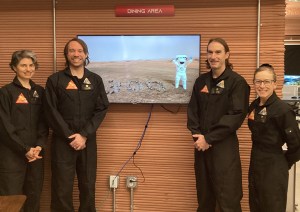
Ross Brockwell: Yeah. And sometimes those tricky ones take encouragement. You get a little frustrated with something and the other person just tells you to keep going. So it definitely helps. And sometimes, of course, you just kind of get hung up on something and you’re just looking at it wrong, so, you know, another person looks at it and sees what you’re missing and helps you move forward.
Nathan Jones: Yeah, it’s easy to get tunnel vision at times when you’re really working on a project and someone else can be like, “Oh, hey, you should just take a step back for a second,” you know? But sometimes I feel like I get in other crew members way, but mostly, it’s helpful to have someone else there with me.
Ross Brockwell: Yeah, absolutely. So there are definitely specific examples where you have to have two people, and then there’s a lot of examples where it’s more engaging and more interesting with two people. So at this point in the mission, do we have any special thoughts we’d like to share with listeners?
Nathan Jones: Some of the interesting things, I think I’ve heard the astronauts on the long duration mission say or refer to the fact that sometimes the moments pass by slowly, but generally time keeps going by pretty quickly. And I’d say that’s pretty true for us as well, or at least for me. You know, it seems sometimes like it takes a really long time to get to certain objectives and then once they hit, they really just go by pretty quickly. The communication issues are sometimes much more difficult and less difficult than what I thought they were going to be. Probably because it usually hits us in places where we didn’t really expect to see them. For instance, you know, if we have a technical glitch or, you know, hardware, we had a, basically a little computer program or a little computer device that had a fan that was going bad on it, and it got pretty noisy and it was in the room where we work as the inside version of the EVA, so the IVA. And so it was really distracting, really loud background noise. And so try to figure out, you know, is this something we just deal with? You know, do we just try and fix it knowing there’s no backup if something goes wrong? You know, how do you deal with that reach? I remember reaching out to mission control and we found out just like so many other times that communicating actual issues we were experiencing was really difficult. So that meant we had to get creative because of leadership on our own.
Ross Brockwell: Always sacrificed to monitor, right? So made an executive decision to trim down what needed to be plugged in so we could get the thing working. So it’s a good example of that.
Nathan Jones: Yeah. But you really have to think about, you know, what you’re going to do whenever you’re solving problems, you know, is it better to just say, “Okay, we’re not just going to use this monitor anymore.” Is it deal with potentially the distraction, putting a crew at risk? You know, the particular computer was going to an essential device. So we ended up moving it offline to one that was less essential, I think, in the end, like I said, and kind of worked our way through it. But it was difficult the communication delays.
Ross Brockwell: Yeah. Like what you said, time flies. It always flies. It seems like you have slow moments, but time flies kind of no matter what. So it’s just a thought for the listeners that keep that in mind. Don’t take anything for granted. I was just thinking yesterday about, you know, the old adage about the best time to plant a tree was 20 years ago, but the next best time is today. So the crops are making me think of that. And, you know, working on the cabin and stuff is making me think of that. And the mission makes you think of that, too. So you feel sometimes like you have a lot of time, but it’s going to go by quickly. So try to take advantage of it, plan for the future, but act on your interests today. And if you didn’t do something you should have done a while ago, do it now. And the mission also makes me think about how, you know, it doesn’t take a lot to be happy, really. You can have a pretty simple existence and it can still be really enjoyable. The most important things are to have something meaningful to work on and commit yourself to something that interests you and a few good people to do it with. And that’s really all it takes. So the mission is driving that home as well.
Nathan Jones: Yeah, it kind of reminds me of a motto we have in my family. It’s do the hard thing now, you know, so it’s really easy to try and put things off, but, you know, there’s something upcoming that you’re going to have to do, kind of grab a hold of it and do it works out usually. Next question is, “What is the first outdoor adventure you’ll embark on once you return to Earth?”
Ross Brockwell: It’ll be hard to pick one. I know when I get home, I’m going to jump in the ocean for sure. So that’ll be early on for me. But first thing probably will just be a simple run, you know, to run outside in the sunlight and the fresh air is going to feel amazing. So that’s probably the very first thing.
Nathan Jones: Or maybe not, it’s going to be Houston in the middle July.
Ross Brockwell: Momentarily, it’ll feel great. See how long that lasts, but I can’t, you know, I’m looking forward, of course, to being outside in the Sun, in the fresh air again. It’s going to be great.
Nathan Jones: Yeah. First thing I will do, actually, it won’t necessarily be my decision. But I always talk about my family because it’s a big part of my life. But it’s one of my family members birthday around the day, and we have this tradition of letting them pick where we’re eating. So I will get to go out to eat at a restaurant, not my choosing. So that’ll be fun. Just getting to hang out with family really is the big picture item there. Just getting to see my family again and everything that so I’m really looking forward to. Yeah, that next morning, definitely going to be up, see that I’m missing those blue skies and everything. I’m sure I would like to see the sunset that night, but might not have a chance with all the post egress activities and everything. So that might be a little bit ambitious. I’m just going to plan on the sunrise the next morning.
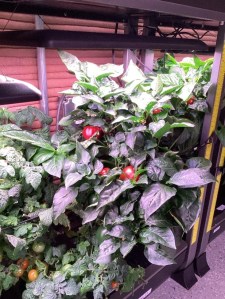
Ross Brockwell: Alright. So what’s coming up in the next month?
Nathan Jones: Well, as you mentioned, we have mission day 300. I think we crossed the four fifths milestones. So again, counting up. As far as those targets go, I think we’re starting to see the light at the end of the tunnel, but none of us, I don’t think are really the mindset of life. We’re quite there yet.
Ross Brockwell: Yeah, still a ways to go. It’ll be savoring those last few harvests that we get for the food crops and more EVA challenges, a couple pieces of unfinished business in the EVAs we want to get to. So still some more things to look forward to and maybe even a few surprises.
Nathan Jones: Yeah, and, and I think I’ll increasingly start looking more towards getting things ready for my return back to my normal work outside of here and getting, you know, credentialing and all those things sorted out. So I think I’m going to be having more and more of that on my mind as we go forward. So it’s actually exciting. I think we’ll probably be getting a little bit more, you know, excited to be getting towards the end of the mission, but also, you know, excited about having those experiences. Some of those experiences we have here, like the EVAs for the last time too.
Ross Brockwell: Yeah, I’m really looking forward to seeing how we’ve helped, you know, move us forward towards getting to Mars.
Host: Alright, that was, again, Flight Engineer Ross Brockwell and Medical Officer Nathan Jones, checking in on again, the 10th month inside the habitat. Really inspirational stuff from the two of them. I really latched onto Ross’s thoughts. It seems like something he was thinking about just sort of as he was working was there’s this idea of motivation and doing it now and when’s the right time to do something, but it’s so interesting to hear that there’s this idea of this motivational thoughts, these very positive thoughts coming from the crew, you know, that seem to continue throughout their journey. Again, going back to Kelly and Anca’s audio log about these milestones to look forward to, this positive attitude just seems to seep from this crew. It’s absolutely incredible to hear. Looking forward to the outdoors, looking forward to seeing family. We’ve been hearing a lot from Nathan’s family who has, of course, been checking in, but I think Kelly made it clear in her audio log, and I’m sure it’s true for Anca as well as Ross, that, you know, family serves as a very important role for everybody. Of course, Nathan has been sharing that very, very openly over the audio logs over the past many months. But something that is really appreciated by all of the different crew members looking forward to food, looking forward to the ocean. It was interesting to hear, I think Anca was the one who was saying she wanted to actually touch the sand at the beach, but everybody seemed to gravitate towards the ocean, found that very fascinating, just wanting to not only experience nature, but there was something maybe about the ocean, something about water that all the crews seemed to really gravitate towards. So that was really interesting to hear.
Once again, glad to hear that all the crew are doing so well, accounting upwards on their milestones and of course really getting ready to transition outside of the habitat. We’ve been talking with them for so long that I think it’s sometimes easy to forget that they’re not just CHAPEA crew members. They have lives outside of this that of course, they volunteered their time to be able to execute this mission and perform great science for humanity. But of course, they have to prepare for their lives outside of the habitat. I think we’ll certainly miss them. It’s too early to say that right now. I know we still have a couple of audio logs left, but this has been such a pleasure for me to get to check in and I hope for the listeners as well to check in with the crew and really go through their journey. I think this crew did a really good job of taking us along on the journey with them. It’s been a wonderful, wonderful ride.
So now let’s switch gears and we’re going to talk with Dr. Lauren Blackwell Landon on the habitability of the Mars Dune Alpha habitat. Alright, Dr. Lauren Blackwell Landon, thank you so much for coming on Houston We Have a Podcast today.
Lauren Blackwell Landon: Well, thank you for having me.
Host: You have a very interesting role, habitability of Mars Dune Alpha, but I’m sure just like many of the other special guests we have here, this is really not your only role. So how would you describe your role here at NASA? And I mean aside from CHAPEA, what you do day-to-day?
Lauren Blackwell Landon: Sure. So I have a few roles, many hats. I work in NASA’s Human Research Program. So I’m the team risk discipline scientist there, which means I oversee research related to teamwork and space kind of generally. I oversee like externally funded people, so usually they’re university professor types that specialize in this area. And I help inform the research plan. So like what topics do we need to tackle to really get us to the Moon and Mars? And we also look at lower orbit a little bit too. So for example, we really need to understand like what communication delays do to a team in space. So when they’re working more autonomously, they’re off on Mars, as well as kind of how that delay might impact the coordination that happens between crew and space. And then mission control on the ground, right? So we have this big team of experts on the ground that they’re working with the whole time. So if you’re communication delays with them, it makes work much more harder. So a lot of that job is kind of to point out the knowledge gaps and the problems that we need to fix. And then, you know, my job is great cause I get to work with some of the top people in the field. All these teams’ researchers that are kind of my heroes. I get to work with them all the time, which is amazing. And my job is to help them understand the NASA context, but also be able to translate what they’ve done for us and their expertise back to the researchers and managers and operations folks on the NASA side so that people understand what psychology is really about here.
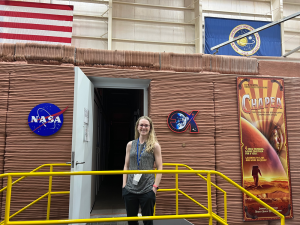
Host: Yeah. Now when you say “we,” right, is of course you’re working with a team and you’re working with a team in the Behavioral Health and Performance Lab now. Exactly. What is that here?
Lauren Blackwell Landon: Yeah, so that’s kind of the biggest part of my day. So I’m a scientist in the Behavioral Health and Performance Lab. So we do the hands-on research to fill those knowledge gaps I was talking about. So I actually get to be involved in study design and data collection analysis and writing up papers. So our lab is really diverse in psychology. We have like neuroscience folks and occupational health psychologists, I myself as an industrial organizational psychologist, which means it’s workplace psychology and teams of course fall into that. So we study things like individual wellbeing, team cohesion, team performance, and then we also kind of like to think of ourselves as honeybees. We go around to all the different flowers or the different research areas like exercise and food and habitability, and we kind of think about how psychology can be infused or pollinate through all those different fields.
Host: A lot to think about. So then within the behavioral and performance lab, how does that relate to CHAPEA?
Lauren Blackwell Landon: Yeah, so for CHAPEA, we have a range of different individual and team measures in the analog, and we are really trying to understand what it’s like to live in this isolated confined environment. And it’s a whole year with the same crew. So imagine trying to live with your coworkers for a whole year. So I’m helping with some of the team’s measurement, but I’m also leading the habitability portion of the study. And this is done in conjunction with my human factors and research expert colleague, Dr. Ian Robertson. So we’re thinking about things like maybe you really love your crew quarters and the privacy that it affords and the design, but then as you go on month to month over time, maybe you don’t love it so much anymore. And so we’re trying to understand the psychology of living within the space for a whole year. So we’re trying to look at the intersection of habitability and usability, which is more of Ian’s kind of human factor side of the house. And then I’m looking at the psychology factor. So what does living in this space sort of do to your wellbeing, to your stress levels after a whole year? And we can think about when we go to Mars, what lessons have we learned from these CHAPEA missions and how can we inform the design for the eventual Mars vehicles?
Host: What I found interesting about your role is you’re thinking so far out, right? We’re talking about CHAPEA, but this is all relating to missions that are way in the future, right? So we’re talking about Mars, but how do you balance thinking about those considerations, but then also kind of staying in the noun and working current operations?
Lauren Blackwell Landon: Right. So teams are teams, right? So every team has conflict and cohesion, and we do team tasks together. So a lot of what we do is related to high performance teams, right? Teams of astronauts, especially when we’re thinking about isolated confined environments. And then all of that research can inform operations. But then we think about the specific problems. So for the Mars mission, it’s going to be 22 minute comm delay, supplies are going to be very restricted. You’re not going to have crew rotations; you’re going to be with the same people that whole time. And so that’s really stressful for a team. So we study team problem-solving and decision making, and we study the space-to-ground coordination that happens when you have the crew and mission control working together. And then we really have to think about the emergency situations when that communication delay is really going to throw us a curve ball. And, you know, we don’t have real time mission control experts ready to help back up the crew and solve those problems with them. That’s really this whole other layer of challenge to kind of the typical team operations.
Host: Yeah. But of course, this is not the first and only time we’ve done a Mars analog. We have experience with other kinds of things. I’m sure you’ve worked on some of them other deep space and Mars analogs besides CHAPEA.
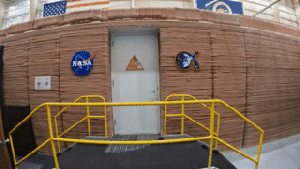
Lauren Blackwell Landon: Yeah, so I’ve overseen several studies that have considered these Mars-like scenarios, but they all do things a little bit differently. They examine kind of different aspects of the mission, or they test different countermeasures. So for example, we have HERA at the Johnson Space Center, so that’s 45-day missions, you know, five minute comm delays. I’ve looked at HI-SEAS, which is down in Hawaii. And so we’ve had multi-month missions there. So we can get more information on teams with HERA through these shorter missions, right? We have more teams going through, but we also sacrifice duration. So we have to kind of balance all of these things, these different missions. And then when we think about after the BHP lab was stood up just a few years ago, I also started participating as an investigator in these analogs, so like HERA. And then we also partnered with our Russian colleagues with the SERIUS mission. So that’s a more Mars-like comm delay for four eight-month mission. And then every environment has a different concept of operations, but they do try to capture some basic things like isolation, confinement, realistic tasks, communication delay. We try to select these really astronaut-like people to partake in them. But each is a little bit different, and you can kind of look at all of them together to try to understand crew health and performance. And one point, I do want to make about teams research, you might hear about it all the time. So we’re doing a series of podcasts, right, about CHAPEA, but that’s one team for an entire year. So we’ve spent a lot of resources, a lot of planning, years of planning, to get just this one team’s data point. So you might hear about a lot of things that are going on, but it takes years of research to even get a few teams on this Mars like mission.
Host: Yeah. But of course, it seems like there’s more analogs and I think it just proves that there’s so much more to learn, right? It’s not like you just do one analog and you stop. It just seems like these, you continue to learn new things as you do more analogs, right?
Lauren Blackwell Landon: Yeah. We’ve learned a lot about teams and Mars teams specifically through analogs, but often the studies from the various research teams are sort of siloed from each other. So we’ll have a bunch of teams go into HERA, but they’re not integrating their studies that that much really. And so a very few missions have also been these long multi-month missions. So I really want to give kudos to Grace Douglas who’s the CHAPE PI (Principle Investigator). You know, she really pushed for this yearlong mission, it’s 378 days, and took a very new approach of integrating across all the different studies, all the different fields from the very beginning. And so that deep integration, really including all the teams research that I’m really excited about and we have this really high EVA workload that these folks are going to be doing that’s really new. It’s really going to give us valuable data at the end of this.
One of my goals really is to get teams research, which is very behaviorally based, kind of traditionally in the literature. I wanted to integrate more with the physiological side of things. So like thinking about how the brain and the body of all the individuals kind of manifest into these effective team behaviors. And we really want to look at the team effects and how they can feed back into the individual and kind of their stress levels, right? We published this theoretical paper on this like in 2019, that was sort of this call to action. Grace Douglas is on there actually. So CHAPEA I think is really great step in this direction.
Host: Yeah. It seems like you’re pretty passionate about CHAPEA. Were you involved from the very beginning? Did you get pulled in early?
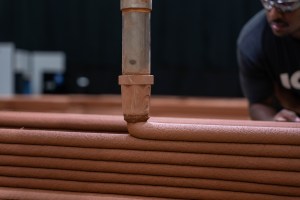
Lauren Blackwell Landon: Yeah, so all those different disciplines started working together a long time ago, a few years ago, from the very beginning. So I was focused more on the traditional kind of behavioral angle, the team’s angle. And then partway into the planning process, we realized that we really need to like directly measure the intersection of habitat design and psychology. So the BHB lab was called upon, and then we went over to our human factors engineering colleagues, which is Ian Robertson, I mentioned before, and we put together this set of measures to really look at different aspects of the habitat, and so we can think about the psychological impact that happens. Then we went and looked at the habitat itself to sort of familiarize ourselves. And it’s really cool. It’s this 3D-printed, you know, habitat from ICON Architecture. It’s 1,700-square feet, so it’s a good size. And the space architecture group and all these other experts weighed in on the design of it. So there’s this, you know, private crew quarters and you have the galley kitchen space and you have private areas for the crew to be in. You also have areas and lounge areas, and you have work rooms and bathrooms, et cetera. So it has all the things that you need to really survive for a whole year. And then the designers really use their expert knowledge, but we don’t really have like this agreed upon design for a Mars mission yet. So part of what we’re trying to do is like put down something that’s concrete that exists, and then we can test people in this specific environment. So we’re going to get a lot of knowledge out of this study, and then we could feed back all of that information to these spec space architecture groups, right? And then we can talk about how to inform the future Mars design.
The other cool thing I always want to tell people about is this 1,200-square-foot sandbox that mimics the Mars surface. And the crews go out and do these EVAs on the Martian surface. They also have virtual reality EVAs that they’re doing, and they can simulate going through the air lock and they put on their suits, and then there’s dust mitigation. So all of this is affecting how they’re experiencing the habitat. So we’re thinking about how all of these issues are going to impact the crew, impact the team, and impact their stress levels living in this habitat.
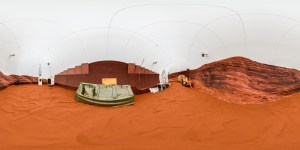
Host: Yeah, there’s a lot that you’re looking at. And so let’s go a little bit into that, right? When it comes to designing a habitat, when it comes to looking at a space, knowing that these folks are going to be in a space, you’re looking at, maybe, you know, how there’s this nice combination of behavioral studies versus the actual architecture of the habitat itself. So things like, you know, private quarters. How big should a habitat be for folks to be comfortable? What are the communal areas like? So give me a sense of the perspective that you are taking. When you look at habitability, when you look at design, what are the main factors that you’re looking at?
Lauren Blackwell Landon: Yeah, there’s been previous research in this area kind of looking at what’s needed for a Mars mission. So several years ago, this group of really amazing experts in this area came together and they decided that individual needs about 25 cubic meters of space to kind of support their psychological wellbeing. And then we also hear from the astronauts, we hear from other experts that privacy is really important for psychological wellbeing. So there’s some things that we do know, and that’s kind of where we can start. And then there’s also the functional spaces that we need on board. So we have, you know, for example, an area that will allow teams to work together on a team task, right? And we have documentation of all this. This is a NASA Standards 3001.
So for example, if you have a mission of 30 days, you need some degree of privacy for the crew quarters that’s in the standards. And then there has to be some sort of medical equipment on board and other things to treat humans. So then on top of that, you build things that we’ve heard from the crews and other psychological research. It might be important to enhance them in some way. So enhance the psychological experience, right? So having a communal space to enjoy meals together, for example, makes it a good way to sort of foster team cohesion, right? So everybody can get together and hang out, and you can leverage that, right? You can leverage them needing to consume food, but also make it a psychologically positive experience.
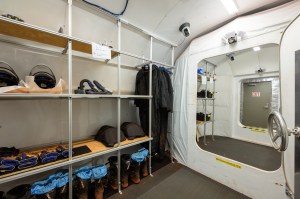
Another example is windows. So windows are always kind of a fun thing from the NASA histories, right? So back in the early days of NASA, they famously designed this capsule without a window, and the astronauts were not happy about that. So they pushed back and they said, “We need a window.” And so now we see that the cupola on the ISS is really psychologically supportive, right? So crews look down, they take pictures about it all the time. They spend free time just gazing at the Earth, and it’s connecting them with nature. It gives them this holistic perspective of the Earth and everything. And it’s really good for them to have this sort of countermeasure up there just from looking out of a window. So we can think about the psychological needs that go along with the kind of basic physiological needs.
Host: So I wonder how you balance that, right? Because of course, you’re taking the perspective of when it comes to habits, task design, when it comes to considerations. You of course are thinking from the human factors perspective, but like you said, right? There are engineering considerations, too. There are challenges when you add a window, there’s challenges when it comes to materials and budgets and how you construct things. So how do you sort of weigh that? How do you work the human factors angle with some of these other considerations that need to be taken, right? The engineering, the materials. How do you balance that?
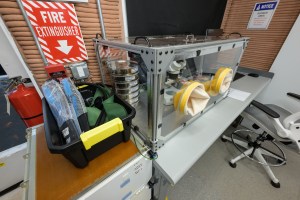
Lauren Blackwell Landon: Well, it’s certainly a push-pull kind of relationship, right? When we think about engineering and psychology. But that intersection is so important, and that’s where that human factors kind of bridges both worlds. They’re able to think about the functionality of what we have to do, the usability of it to get stuff done. And then also we can think about the psychology of how do we get things done where people are not stressed out about getting it done right? Is it easy to use? So if you walk up to a system, it’s hard to use, you’re probably not going to want to use it. So we can measure the psychological stress part of it. They can measure the usability part of it, and then we get this really good integrated picture of what the design issues may be or like what parts are working really well, so that then we can capitalize on that later.
And then there’s also, of course, cost and launching materials is very costly. And so we can also think about if we need a standard or a requirement, maybe we don’t outline all the nuances of every specific detail, but we can talk about basic needs. So I mentioned privacy before. So if we have privacy for the crew quarters, there’s probably different ways to achieve privacy. You can have a door, you can have a curtain, maybe people can just, you know, put on some headphones and achieve some sort of privacy that way. And then the engineers can come back on top of that requirement and use their knowledge of perhaps materials and think about an innovative way that kind of meets the psychological need. But also, they can engineer and do really interesting things. I think that’s where this interdisciplinary nature of research and applied research is really important. We can think about it from different fields altogether.
Host: So then let’s take that angle of research, right, and talk about your role specifically with CHAPEA, right? You look at the habitat that is CHAPEA and the way that it’s designed, and you’re working to understand the habitability function of that specific habitat. So when you are looking at CHAPEA as an investigator, what exactly is it that you’re doing? What is it that you’re evaluating as part of this mission in terms of the design of that habitat and how it affects performance?
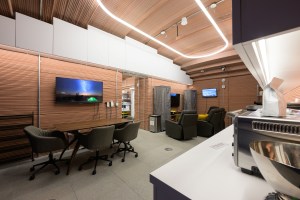
Lauren Blackwell Landon: Right. So we’re asking the crew to think about different habitat areas over time. So every couple of months we’ll ask them to sort of answer the series of questions about, for example, their sleep quarters or the kitchen area, their work area, and then think about how that has different kind of psychological impacts or outcomes for them. So is it impacting your performance? Does it affect your team? What is your stress or mood level when you are using this area? And so that measures called SHAQ. We’ve published a lot of this stuff. SHAQ of course, very, very funny name for this. Then we also have a questionnaire that asks them more specifically about the usability of space. This is the shoe questionnaire. And then so we can look at the design and help them get their job done or help them do kind of their general living tasks that they need to do to survive in this environment.
Then we also think about really nuanced detail rich data. And so we allow them to do another measure called the iSHORT, which is essentially a video blog. They can go and record themselves, you know, kind of, “Hey, here’s the treadmill, here’s all the things I don’t like about this. Here’s the exercise equipment.” And we can get really nuanced data about all those different things. And then we’re also able to discuss aspects of the habitat as a team. And so they have team meetings and they might talk about how they want to change certain things or how they would reconfigure certain things. And having them think about that, really doing that reflection is really helpful to give us a lot of good, interesting data about how they might do things better. And eventually at the end of the mission, we’re going to ask them to kind of do a retrospective. So now that you’re out of the habitat, what happened over the course of that habitat? What changed over time? Basically, we want to understand if we can help make things more useful, but also more psychologically supportive. That’s kind of what I care about the most is, you know, we have to have design help achieve the task, but can we do it in such a way that people are also resilient because they’re doing these tasks?
Host: Yeah. And it’s over a really long period of time. I’m sure that’s a huge factor. Not only just the design, but the fact that they’re there for a while.
Lauren Blackwell Landon: Right. The other thing we’re really interested in, especially me as a teams researcher, is the idea of them living together for a full year. So they’re roommates, right? So we can actually ask them about group living and what it’s like to live with their crew mates in addition, in addition to team processes and cohesion, all that good stuff. But specifically, we want to know, like, are you a tidy person? Are you considerate of the other people you’re living with? Do you appreciate the skills and abilities that they bring into this habitat? And it’s not just for work, it’s also for living. So I’m really excited to kind of understand more about the group living dynamic in addition to how they’re just interacting with the habitat.
Host: It’s probably helpful, the fact that this is not anyone’s first go around. Well, not maybe for some, but for you who have, you know, you’ve worked on different analogs, this is not your first time actually approaching it and understanding what needs to go into getting really good data as part of an analog. You’re probably pulling lessons from some of your previous work.
Lauren Blackwell Landon: Right. We’re actually fortunate that CHAPEA kind of came along as it did, because all this other research that we’ve been doing in isolated, confined environments with teams, of course, has resulted in this really solid set of measures that help us look at behavioral health and performance. So we’re easily able to just throw that into CHAPEA. We adapted a little bit for the needs of CHAPEA, of course. It’s called the Human Factors and Behavioral Performance Exploration Measure Suite. It’s a mouthful. If folks want to use it, just give us a call. We’re happy to share these measures. So we’ve made a lot of the measurement quite easy. We just adapted the frequency and the protocols. And we’ve also looked at other task performance, things that go into CHAPEA, like the EVAs are going to be a really critical one. So we have a whole team that’s really experienced and they’re thinking about the EVAs. And of course, EVAs is a team task. And so we’re able to come on top of what they’re thinking about and then bring our psychological expertise to the aspect of CHAPEA EVAs. And like I said, it’s a really integrated from the beginning at CHAPEA. So that new approach to integration’s really going to allow us to understand all these different push points. So we’re thinking about like the different areas of research, how they affect the other areas, and how we can do a more integrated analysis at the end of this whole thing.
Host: You take all these different aspects that you’ve been mentioning, Lauren. And really big question is that I think a lot of our listeners are thinking about is all the research that you’re doing now, all the research you’ve gathered over previous analogs, is the hope maybe that some of the things that we learn as part of this mission, as part of continued CHAPEA missions, eventually going to be to applied. Like you mentioned, like the idea of like privacy, right? Not just the specific design, but just the idea of privacy. Just things that we are learning from these analogs actually being applied to future human missions to Mars.
Lauren Blackwell Landon: Oh, absolutely., I mean, the whole point of this is to take lessons learned from this series of three missions. So we have three missions plans. This is just our first and we’re going to take all the lessons learned from these three different crews that are in there for a whole year, and then we’re going to do something with that knowledge. So it’s very applied research. So there’s a lot of time and energy that we’re using, you know, not just us on the research side, but we’re taking the crews away from their families and friends for an entire year. So we certainly want to make it worth their while. And one day, we’re going to use this to inform all the habitat design for our future Mars mission. So what they’re doing will lead us to Mars someday. So stay tuned. We have many papers to write over the next few years.
Host: I’m excited that you are excited about all of the research that you’re getting. A lot to learn and a lot to look forward to. Lauren Blackwell Landon, thank you so much for coming on Houston We Have a Podcast today. This was so much fun.
Lauren Blackwell Landon: Thank you.
[Music]
Host: Alright, that’s it for Audio Log #10 from Dune Alpha. Thanks for sticking around. I hope you’re enjoying the crews journey as much as I am. Again, that was the 10th audio log in our series. Tune in for the final two over the next coming months. Check in at nasa.gov for the latest on what’s happening with the CHAPEA crew and nasa.gov/podcasts to check out our show, as well as the many others that we have across the agency. If you want to talk to us on social media, we’re on the Johnson Space Center pages of Facebook, X, and Instagram. And you can use #AskNASA on your favorite platform to submit an idea for the show, just make sure to mention it’s for us at Houston We Have a Podcast.
Recordings were sent in from the CHAPEA crew through April. And we had the conversation with Lauren Blackwell Landon on May 10, 2024. Thanks to Will Flato, Beth Weisinger, Dane Turner, Abby Graf, Jaden Jennings, Anna Schneider, Laura Sorto, and Kelsey Spivey. Thanks again to Dr. Lauren Blackwell Landon for taking the time to come on the show. Thanks to Grace Douglas and Jennifer Miller for their efforts in reviewing these audio log episodes. And big thanks to Kelly Haston, Ross Brockwell, Nathan Jones and Anca Selariu for sharing their experience for this audience on Houston We Have a Podcast. Give us a rating and feedback on whatever platform you’re listening to and tell us what you think of our podcast. We’ll be back next week.
This is an Official NASA Podcast.


























